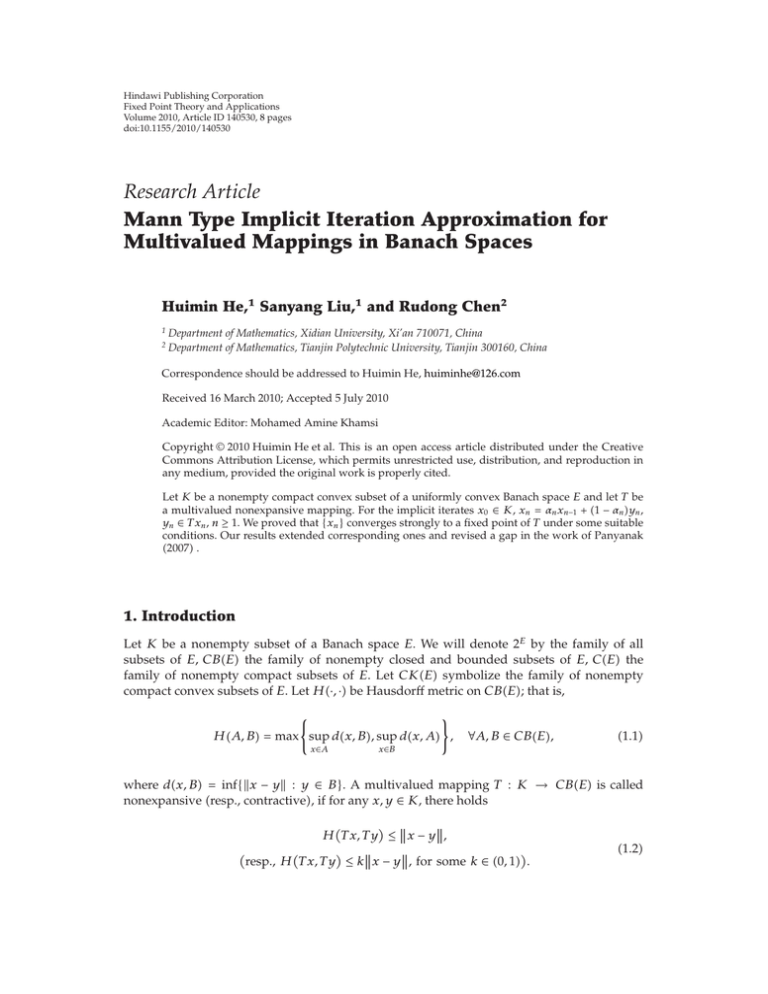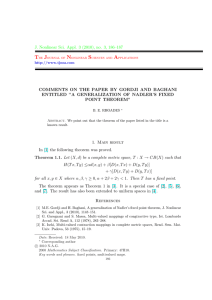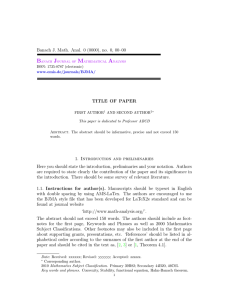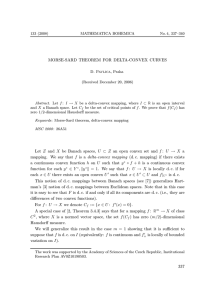Document 10858613
advertisement

Hindawi Publishing Corporation
Fixed Point Theory and Applications
Volume 2010, Article ID 140530, 8 pages
doi:10.1155/2010/140530
Research Article
Mann Type Implicit Iteration Approximation for
Multivalued Mappings in Banach Spaces
Huimin He,1 Sanyang Liu,1 and Rudong Chen2
1
2
Department of Mathematics, Xidian University, Xi’an 710071, China
Department of Mathematics, Tianjin Polytechnic University, Tianjin 300160, China
Correspondence should be addressed to Huimin He, huiminhe@126.com
Received 16 March 2010; Accepted 5 July 2010
Academic Editor: Mohamed Amine Khamsi
Copyright q 2010 Huimin He et al. This is an open access article distributed under the Creative
Commons Attribution License, which permits unrestricted use, distribution, and reproduction in
any medium, provided the original work is properly cited.
Let K be a nonempty compact convex subset of a uniformly convex Banach space E and let T be
a multivalued nonexpansive mapping. For the implicit iterates x0 ∈ K, xn αn xn−1 1 − αn yn ,
yn ∈ T xn , n ≥ 1. We proved that {xn } converges strongly to a fixed point of T under some suitable
conditions. Our results extended corresponding ones and revised a gap in the work of Panyanak
2007 .
1. Introduction
Let K be a nonempty subset of a Banach space E. We will denote 2E by the family of all
subsets of E, CBE the family of nonempty closed and bounded subsets of E, CE the
family of nonempty compact subsets of E. Let CKE symbolize the family of nonempty
compact convex subsets of E. Let H·, · be Hausdorff metric on CBE; that is,
HA, B max sup dx, B, sup dx, A ,
x∈A
∀A, B ∈ CBE,
1.1
x∈B
where dx, B inf{x − y : y ∈ B}. A multivalued mapping T : K → CBE is called
nonexpansive resp., contractive, if for any x, y ∈ K, there holds
H T x, T y ≤ x − y,
resp., H T x, T y ≤ kx − y, for some k ∈ 0, 1 .
1.2
2
Fixed Point Theory and Applications
A point x is called a fixed point of T if x ∈ T x. In this paper, FT stands for the fixed point
set of a mapping T .
The fixed point theory of multivalued nonexpansive mappings is much more
complicated and difficult than the corresponding theory of single-valued nonexpansive
mappings. However, some classical fixed point theorems for single-valued nonexpansive
mappings have already been extended to multivalued mappings.
In 1968, Markin 1 firstly established the nonexpansive multivalued convergence
results in Hilbert space. Banach’s Contraction Principle was extended to a multivalued
contraction in 1969. Below is stated in a Banach space setting.
Theorem 1.1 see 2. Let K be a nonempty closed subset of a Banach space E and T : K → CBK
a multivalued contraction. Then T has a fixed point.
In 1974, one breakthrough was achieved by Lim using Edelstein’s method of
asymptotic centers 3.
Theorem 1.2 see Lim 3. Let K be a nonempty closed bounded convex subset of a uniformly
convex Banach space E and T : K → CE a multivalued nonexpansive mapping. Then T has a fixed
point.
In 1990, Kirk and Massa 4 obtained another important result for multivalued
nonexpansive mappings.
Theorem 1.3 see Kirk and Massa 4. Let K be a nonempty closed bounded convex subset of
a Banach space E and T : K → CKE a multivalued nonexpansive mapping. Suppose that the
asymptotic center in E of each bounded sequence of X is nonempty and compact. Then T has a fixed
point.
In 1999, Sahu 5 obtained the strong convergence theorems of the nonexpansive type
and nonself multivalued mappings for the following 1.3 iteration process:
xn tn u 1 − tn yn ,
n ≥ 0,
1.3
where yn ∈ T xn , u ∈ K, tn ∈ 0, 1 and limn → ∞ tn 0. He proved that {xn } converges strongly
to some fixed points of T . Xu 6 extended Theorem 1.3 to a multivalued nonexpansive
nonself mapping and obtained the fixed theorem in 2001. The recent fixed point results for
nonexpansive mappings can be found in 7–12 and references therein.
Recently, Panyanak 13 studied the Mann iteration 1.4 and Ishikawa iterative
processes 1.5 for x0 ∈ K as follows:
xn1 αn xn 1 − αn yn ,
n ≥ 0,
1.4
where αn ∈ 0, 1, yn ∈ T xn , and fixed p ∈ FT are such that yn − p ≤ dp, T xn ,
yn 1 − βn xn βn zn ,
xn1 1 − αn xn αn zn ,
n ≥ 0,
1.5
Fixed Point Theory and Applications
3
where αn ∈ 0, 1, βn ∈ 0, 1, zn ∈ T xn , zn ∈ T yn , and fixed p ∈ FT are such that zn −
p ≤ dp, T xn and zn − p ≤ dp, T yn and proved the strong convergence theorems for
multivalued nonexpansive mappings T in Banach spaces.
In this paper, motivated by Panyanak 13 and the previous results, we will study the
following iteration process 1.6. Let K be a nonempty convex subset of E, αn ∈ 0, 1,
x0 ∈ K,
xn αn xn−1 1 − αn yn ,
yn ∈ T xn , n ≥ 1,
1.6
and we prove some strong convergence theorems of the sequence {xn } defined by 1.6 for
nonexpansive multivalued mappings in Banach spaces. The results presented in this paper
establish a new type iteration convergence theorems for multivalued nonexpansive mappings
in Banach spaces and extend the corresponding results of Panyanak 13.
2. Preliminaries
Let E be a real Banach space and let J denote the normalized duality mapping from E to 2E
defined by
Jx f ∈ E∗ , x, f xf , x f ,
∀x ∈ E,
∗
2.1
where E∗ denotes the dual space of E and ·, · denotes the generalized duality pair. It is well
known that if E∗ is strictly convex, then J is single valued. And if Banach space E admits
sequentially continuous duality mapping J from weak topology to weak star topology, then,
by 14, Lemma 1, we know that the duality mapping J is also single valued. In this case,
the duality mapping J is also said to be weakly sequentially continuous; that is, if {xn } is a
∗
subject of E with xn x, then Jxn Jx. By Theorem 1 of 14, we know that if E admits
a weakly sequentially continuous duality mapping, then E satisfies Opial’s condition, and E
is smooth; for the details, see 14. In the sequel, we will denote the single-valued duality
mapping by j.
∗
Throughout this paper, we write xn x resp., xn x to indicate that the sequence
xn weakly resp., weak ∗ converges to x, as usual xn → x will symbolize strong convergence.
In order to show our main results, the following concepts and lemmas are needed.
A Banach space E is called uniformly convex if for each > 0 there is a δ > 0 such
that for x, y ∈ E with x, y ≤ 1 and x − y ≥ , x y ≤ 21 − δ holds. The modulus of
convexity of E is defined by
1
δE inf 1 − x y : x, y ≤ 1, x − y ≥ ,
2
2.2
for all ∈ 0, 2. E is said to be uniformly convex if δE 0 0, and δ > 0 for all
0 < ≤ 2.
4
Fixed Point Theory and Applications
Lemma 2.1 see 10. In Banach space E, the following result (subdifferential inequality) is well
known: for all x, y ∈ E, for all jx ∈ Jx, for all jx y ∈ Jx y,
2
x2 2 y, jx ≤ x y ≤ x2 2 y, j x y .
2.3
Definition 2.2. A Banach space E is said to satisfy Opial’s condition if for any sequence {xn } in
E, xn x n → ∞ implies
lim supxn − x < lim supxn − y,
n→∞
n→∞
∀y ∈ E with x /
y.
2.4
We know that Hilbert spaces, lp 1 < p < ∞, and Banach space with weakly
sequentially continuous duality mappings satisfy Opial’s condition; for the details, see
14, 15.
Definition 2.3. A multivalued mapping T : K → CBK is said to satisfy Condition I if there is
a nondecreasing function f : 0, ∞ → 0, ∞ with f0 0, fr > 0 for r ∈ 0, ∞ such that
dx, T x ≥ fdx, FT ,
∀x ∈ K.
2.5
Example of mappings that satisfy Condition I can be founded in 13.
3. Main Results
Now, we prove our results.
Theorem 3.1. Let K be a nonempty compact convex subset of a uniformly convex Banach space E and
let T : K → CBK be a multivalued nonexpansive mapping, where αn ∈ 0, 1 and limn → ∞ αn 0,
the sequence {xn }∞
n1 is generated by 1.6.
Then,
i by the compactness of K, there exists a subsequence {xni } of {xn } such that xni → p for
some p ∈ K. In addition if yn − p ≤ dp, T xn , then
ii p is a fixed point of T and the sequence {xn } converges strongly to p.
Proof. Part i is trivial. And part ii remains to be proved.
Due to the compactness of K and boundness of CBK, there exists a real number
M > 0 such that
xn−1 − yn ≤ M.
3.1
xn − yn αn xn−1 − yn ≤ αn M,
3.2
It follows from 1.6, that
Fixed Point Theory and Applications
5
thus
xn − yn −→ 0,
as n −→ ∞,
3.3
therefore
d p, T p ≤ p − xn dxn , T xn H T xn , T p
≤ 2p − xn dxn , T xn ≤ 2p − xn xn − yn ,
3.4
so
d p, T p −→ 0,
as n −→ ∞.
3.5
Hence, p is a fixed point of T .
Next we show that limn → ∞ xn − p exists.
For all n ≥ 1, there exist jxn − p ∈ Jxn − p, using Lemma 2.1, we obtain
xn − p2 αn xn−1 1 − αn yn − p, j xn − p
1 − αn yn − p, j xn − p αn xn−1 − p, j xn − p ≤ 1 − αn yn − p · xn − p αn xn−1 − p · xn − p
≤ 1 − αn H T xn , T p · xn − p αn xn−1 − p · xn − p
2
≤ 1 − αn xn − p αn xn−1 − p · xn − p,
3.6
xn − p2 ≤ xn−1 − p · xn − p.
3.7
so
If xn − p 0, then limn → ∞ xn − p 0 apparently holds.
Let xn − p > 0, from 3.7, we have
xn − p ≤ xn−1 − p.
3.8
We get that {xn − p} is a decreasing sequence, so
lim xn − p exists.
n→∞
So the desired conclusion follows.
The proof is completed.
3.9
6
Fixed Point Theory and Applications
Remark 3.2. The above result modified the gap in the proof of Theorem 3.1 in 13 by a new
method; the gap discovered by Song and Wang 16 is as follows.
Panyanak 13 introduced the Ishikawa iterates 1.5 of a multivalued mapping T . It is
obvious that xn depends on p and T . For p ∈ FT , we have
zn − p d p, T xn ≤ H T p, T xn ≤ xn − p,
zn − p d p, T yn ≤ H T p, T yn ≤ yn − p.
3.10
Clearly, if q ∈ FT and q /
p, then the above inequalities cannot be assured. Indeed, from the
monotone decreasing sequence of {xn − p} in the proof of Theorem 3.1 13, we cannot
obtain that {xn − q} is a decreasing sequence. Hence, the conclusion of Theorem 3.1 in 13
cannot be achieved.
Theorem 3.3. Let E be a Banach space satisfying Opial’s condition and let K be a nonempty weakly
compact convex subset of E. Suppose that T : K → CBK is a multivalued nonexpansive mapping,
where αn ∈ 0, 1 and limn → ∞ αn 0, the sequence {xn }∞
n1 is generated by 1.6.
Then,
i by the weak compactness of K, there exists a subsequence {xni } of {xn } such that xni p
for some p ∈ K. In addition if, yn − p ≤ dp, T xn , then
ii p is a fixed point of T and the sequence {xn } converges weakly to p.
Proof. Part i is trivial. Now we prove part ii.
It follows from 3.3 of Theorem 3.1 that
lim dxn , T xn 0.
3.11
n→∞
Since K is weakly compact, from part i, there exists a subsequence {xni } of {xn } such that
xni p,
for some p ∈ K.
3.12
Suppose that p does not belong to T p. By the compactness of T p, for any given xni , there exist
zi ∈ T p such that xni − zi dxni , T p and zi → z ∈ T p.
Thus p /
z, from
lim supxni − z ≤ lim supxni − zi zi − z
i→∞
i→∞
lim supxni − zi i→∞
≤ lim sup dxni , T xni H T xni , T p
i→∞
≤ lim supxni − p < lim supxni − z.
i→∞
This is a contradiction by satisfying Opial’s condition.
i→∞
3.13
Fixed Point Theory and Applications
7
Hence, p is a fixed point of T .
It follows from 3.7 of Theorem 3.1 that
lim xn − p exists.
3.14
n→∞
Next we show xn p. Suppose not. There exists another subsequence {xnk } of {xn }
such that xnk q / p.
Then, we also obtain q ∈ T q. From Opial’s condition, we have
lim xn − p lim supxni − p
i→∞
i→∞
< lim supxni − q lim supxnk − q
i→∞
k→∞
3.15
< lim supxnk − p lim xn − p.
k→∞
i→∞
Which is a contradiction, so the conclusion of the theorem follows.
The proof is completed.
Corollary 3.4. Let E be a reflexive Banach space which admits a weakly sequentially continuous
duality mapping J from E to E∗ , and let K be a nonempty weakly compact convex subset of E. Suppose
that T : K → CBK is a multivalued nonexpansive mapping, where αn ∈ 0, 1 and limn → ∞ αn 0, the sequence {xn }∞
n1 is generated by 1.6.
Then,
i by the weak compactness of K, there exists a subsequence {xni } of {xn } such that xni p
for some p ∈ K. In addition if, yn − p ≤ dp, T xn , then
ii p is a fixed point of T and the sequence {xn } converges weakly to p.
Proposition 3.5. Let K be a nonempty compact convex subset of a uniformly convex Banach space E
and let T : K → CBK be a multivalued nonexpansive mapping. Then FT is a closed subset of K.
Proof. Suppose qn ⊂ FT , n ≥ 1, such that limn → ∞ qn q, then we have
d q, T q ≤ p − qn d qn , T qn H T qn , T q
≤ 2q − qn d qn , T qn ,
3.16
so
d q, T q −→ 0,
Hence, q is a fixed point of T .
Thus, FT is a closed subset of K.
The proof is completed.
as n −→ ∞.
3.17
8
Fixed Point Theory and Applications
Theorem 3.6. Let K be a nonempty compact convex subset of a uniformly convex Banach space E
and let T : K → CBK be a multivalued nonexpansive mapping satisfying Condition I, where
αn ∈ 0, 1 and limn → ∞ αn 0, then the sequence {xn }∞
n1 generated by 1.6 converges strongly to a
fixed point.
Proof. It follows from 3.3 of Theorem 3.1 that
lim dxn , T xn 0.
n→∞
3.18
The proof of remained part is omitted because it is similar to the proof of Theorem 3.8
in 13.
Acknowledgment
The work was supported by the Fundamental Research Funds for the Central Universities,
No. JY10000970006, and National Nature Science Foundation, No. 60974082.
References
1 J. T. Markin, “A fixed point theorem for set valued mappings,” Bulletin of the American Mathematical
Society, vol. 74, pp. 639–640, 1968.
2 S. B. Nadler Jr., “Multi-valued contraction mappings,” Pacific Journal of Mathematics, vol. 30, pp. 475–
488, 1969.
3 T. C. Lim, “A fixed point theorem for multivalued nonexpansive mappings in a uniformly convex
Banach space,” Bulletin of the American Mathematical Society, vol. 80, pp. 1123–1126, 1974.
4 W. A. Kirk and S. Massa, “Remarks on asymptotic and Chebyshev centers,” Houston Journal of
Mathematics, vol. 16, no. 3, pp. 357–364, 1990.
5 D. R. Sahu, “Strong convergence theorems for nonexpansive type and non-self-multi-valued
mappings,” Nonlinear Analysis: Theory, Methods & Applications, vol. 37, no. 3, pp. 401–407, 1999.
6 H.-K. Xu, “Multivalued nonexpansive mappings in Banach spaces,” Nonlinear Analysis: Theory,
Methods & Applications, vol. 43, no. 6, pp. 693–706, 2001.
7 Y. Feng and S. Liu, “Fixed point theorems for multi-valued contractive mappings and multi-valued
Caristi type mappings,” Journal of Mathematical Analysis and Applications, vol. 317, no. 1, pp. 103–112,
2006.
8 J. S. Jung, “Strong convergence theorems for multivalued nonexpansive nonself-mappings in Banach
spaces,” Nonlinear Analysis: Theory, Methods & Applications, vol. 66, no. 11, pp. 2345–2354, 2007.
9 D. Turkoglu and I. Altun, “A fixed point theorem for multi-valued mappings and its applications to
integral inclusions,” Applied Mathematics Letters, vol. 20, no. 5, pp. 563–570, 2007.
10 T. Domı́nguez Benavides and B. Gavira, “The fixed point property for multivalued nonexpansive
mappings,” Journal of Mathematical Analysis and Applications, vol. 328, no. 2, pp. 1471–1483, 2007.
11 R. Chen and H. He, “Viscosity approximation of common fixed points of nonexpansive semigroups
in Banach space,” Applied Mathematics Letters, vol. 20, no. 7, pp. 751–757, 2007.
12 H. He, X. Wang, R. Chen, and N. Cakic, “Strong convergence theorems for the implicit iteration
process for a finite family of hemicontractive mappings in Banach space,” Applied Mathematics Letters,
vol. 22, no. 7, pp. 990–993, 2009.
13 B. Panyanak, “Mann and Ishikawa iterative processes for multivalued mappings in Banach spaces,”
Computers & Mathematics with Applications, vol. 54, no. 6, pp. 872–877, 2007.
14 J.-P. Gossez and E. Lami Dozo, “Some geometric properties related to the fixed point theory for
nonexpansive mappings,” Pacific Journal of Mathematics, vol. 40, pp. 565–573, 1972.
15 K. Yanagi, “On some fixed point theorems for multivalued mappings,” Pacific Journal of Mathematics,
vol. 87, no. 1, pp. 233–240, 1980.
16 Y. Song and H. Wang, “Convergence of iterative algorithms for multivalued mappings in Banach
spaces,” Nonlinear Analysis: Theory, Methods & Applications, vol. 70, no. 4, pp. 1547–1556, 2009.


